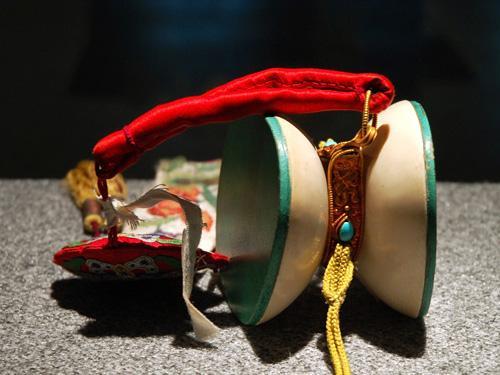The shape and structure of damaru
492 views · Organized by Susan on 2022-02-11
With a long history, its shape is similar to the ancient shank drum. It is a small double-sided slender-waisted rattle without a wooden handle, but it is different from the rattle spread in the mainland. The drum body is composed of two bowl-shaped cavities that are butted at the bottom and communicated in the middle waist.
In the old days, the skulls of two more people in the Tibetan area were made, and a hole was drilled in the center of the bottom, and glued to the wooden annular joint.
Some monasteries are also made of ivory, and the whole piece of ivory is selected to carve into shape. The Danbulenger in Tibetan Buddhist monasteries in Mongolian areas is mostly made of purple wood or mahogany. Drums vary in size and specifications. For the larger ones, the diameter of the drum surface is 20 cm to 30 cm, the thickness of the drum (two bowl-shaped drum shells) is 10 cm to 12 cm, and most of them are made of wood. The smaller ones, the diameter of the drum surface is 7 cm to 10 cm, the thickness of the drum is 7 cm to 8 cm, and most of them are made of human skull or ivory.
The drum surfaces at both ends of the small damaru are covered with dark green sheepskin (soak the film in patina and acid solution for coloring);
In the old days, the skulls of two more people in the Tibetan area were made, and a hole was drilled in the center of the bottom, and glued to the wooden annular joint.
Some monasteries are also made of ivory, and the whole piece of ivory is selected to carve into shape. The Danbulenger in Tibetan Buddhist monasteries in Mongolian areas is mostly made of purple wood or mahogany. Drums vary in size and specifications. For the larger ones, the diameter of the drum surface is 20 cm to 30 cm, the thickness of the drum (two bowl-shaped drum shells) is 10 cm to 12 cm, and most of them are made of wood. The smaller ones, the diameter of the drum surface is 7 cm to 10 cm, the thickness of the drum is 7 cm to 8 cm, and most of them are made of human skull or ivory.
The drum surfaces at both ends of the small damaru are covered with dark green sheepskin (soak the film in patina and acid solution for coloring);


Involving musical instruments
Damaru (Pinyin: Dá mǎ rú) is a Tibetan and Mongolian musical instrument that strikes the membrane. Tibetan is also known as Daru and Dari. In Mongolian, it is called Danbulenger and Bulenger. The Han people call it Dharma drum and rattle drum. It is popular in Tibetan Buddhist monasteries in Tibet and Inner Mongolia Autonomous Region.
Guess you like
Organized by 黑猫不是喵 on 2022-02-11
When playing, the monk's right thumb and index finger hold the waist of the drum, and the rest of the fingers support the colored ribbons or drum ears, and quickly turn the wrist back and forth to make the drum pendant hit both ends of the drum surface to make a sound, and the sound is crisp and loud.
read >>
 渝公网安备 50010702504639号
渝公网安备 50010702504639号